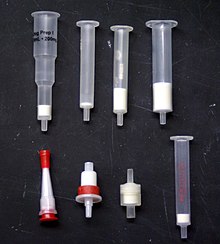Solid phase extraction
The solid phase extraction ( English solid phase extraction , shortly SPE , older term also sorbent extraction ) is a sample preparation method with respect to a possible accumulation, concentration or isolation of an analyte. It is a physical extraction process that takes place between a liquid and a solid phase ( sorbent ), similar to column chromatography . However, the term is broader and includes a whole series of sorbent / isolate interactions: polar and non-polar interactions, ionic interactions, interactions via covalent bonds and multiple interactions.
The component to be analyzed ( analyte ) is dissolved in a solvent . With the help of SPE it is possible to enrich the component to be determined from very dilute solutions for the actual analysis. If the solvent or the sample solution is passed through the sorbent, the isolate accumulates on the sorbent bed, with the solvent passing through the sorbent unhindered. The choice of sorbent has a major impact on the extraction. The most common SPE method is to pack the sorbent in some sort of column and pass the sample solution through the sorbent. The isolate is removed from the sorbent using a suitable solvent ( elution ). This eluate can then be further processed or analyzed.
The method development of a complete SPE analysis validation can sometimes appear quite time-consuming and complicated. However, the result is a fast and inexpensive analysis method, which speaks for large sample quantities and a high degree of automation. Commercially available columns are used for this. Traditionally, manually operated SPEs with a vacuum tray are used for this. Modern machines enable fully automatic enrichment.
Important areas of application include the determination of the minor constituents of the unsaponifiable in complex oils and fats such as B. of sterols and phospholipids and of lipid classes in complex biological test materials.
literature
- EM Thurman, MS Mills: Solid-Phase Extraction - Principles and Practice. In: JD Winefordner (Ed.): Chemical Analysis, Volume 147, A Series of Monographs on Analytical Chemistry and its Applications. John Wiley & Sons, Inc., New York / Chichester / Weinheim / Brisbane / Singapore / Toronto 1998, ISBN 0-471-61422-X .
Web links
Individual evidence
- ^ V. Ruiz-Gutiérrez, MC Pérez-Camino: Update on solid-phase extraction for the analysis of lipid classes and related compounds . In: Journal of Chromatography A . tape 885 , no. 1-2 , July 14, 2000, pp. 321-341 , doi : 10.1016 / S0021-9673 (00) 00181-3 , PMID 10941680 (review article).
- ↑ YM Pacheco, MC Pérez-Camino, A. Cert, E. Montero, V. Ruiz-Gutiérrez: Determination of the molecular species composition of diacylglycerols in human adipose tissue by solid-phase extraction and gas chromatography on a polar phase . In: Journal of Chromatography B: Biomedical Sciences and Applications . tape 714 , no. 2 , September 4, 1998, pp. 127-132 , doi : 10.1016 / S0378-4347 (98) 00231-X , PMID 9766852 .

